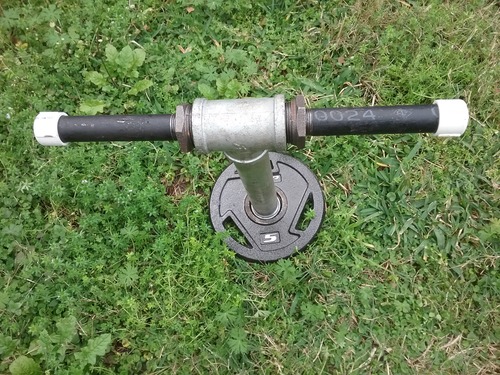
Kettlebell
Use kettlebell exercises for building hip and leg muscles.
Exercises
Do one exercise set with a challenging, but safe to carry weight. When you hit a plateau, rest for more days up to 3 weeks. Injuries, including microinjuries require more rest days.
Don't do any exercises where the T-handle kettlebell is over your head, directly over feet or over any other part of your body. Also, do not do any jerky motion exercises, and don't fling the kettlebell around even for exercises that call for it. Do not lift the kettlebell with your back. Don't squat past 60° from standing position at knees (leg angle would be over 120°, or between seat and standing position), and also do not lock knees (at near standing position) during squats. This is to reduce pressure or potential wear on the knees.
The handles of a 1" or 11/4" steel pipe may not be ideal for grip, but the exercise is only for 1 or 2 sets about 2 times a week or less. Kettlebell exercises with slightly challenging weights don't require running or jumping like motions.
For examples of kettlebell exercises, see exrx.net. Keep in mind, not all exercises are ideal for this kettlebell, such as fast moving exercises, jumping exercises, or exercises that position the kettlebell over any part of the body.
T-handle kettlebells on this page are intended for steady motion exercises. Foot stance may also need to be apart, and knees bending outward to exercise with this kettlebell, but not in any way that can be tough on joints. Don't fling the kettlebell around for exercises, and do not lift the kettlebell directly over feet, or over the rest of the body.
DIY T-handle kettlebell
The following are instructions on making T-handle kettlebells out of steel pipe and fittings. The heavy duty T-handle kettlebell costs more to build, but is recommended over the DIY kettlebell for standard weight plates. This heavy duty kettlebell still costs less than store bought heavy kettlebells, and can be adjusted.
The tee and flange is where there will be the most strain and wear on the kettlebell. The steel tee and handles must be over 1" in diameter. Perhaps the strength will be overly redundant, but that's better than to worry. With a maleable black steel tee and handles you can notice if it curves over time, but this is more likely with more torque from a longer pipe. The force of weight multiplies in movements such as jumping. Steel black and galvanized pipe is usually strong enough to account for that, but I need to be sure of structural wear and rust.
The smaller diameter the pipe, the less length the steel pipes can be. Longer pipes require more strength by the diameter of the pipe.
The biggest danger to the structure of the tee and flange that can cause cracking is from dropping or slamming the kettlebell, especially with heavy weights, on a hard surface. The steel post would simply transfer the impact to the tee. There are stories of cracking along the flange to the tee, especially for 3/4" or smaller diameter steel pipe and fittings in a matter of months. Dropping heavy weights on the floor certainly contribute heavily to breaking apparatus. It is uncertain if there are other major contributors to this problem for steel pipe 3/4" or less in diameter.
Handle length must be so hands can fit along the pipe completely between the threads, which is about 4" plus extra room, but ideally need to be 5" or 6". PVC end caps are not weight bearing, but are very important to prevent serious injury from exposed sharp handles.
Steel pipe and fittings are not intended to screw together all the way, as shown in the pictures. All fittings and pipe must be screwed together tightly with a pipe wrench, except for the part that needs to come undone by hand so weight plates can be changed. Where the tee or bushing on tee connects to the bottom post should be tightened by hand just enough to be snug, but loose enough that it can be unscrewed by hand.
Inspect the kettlebell before each use or periodically. Check for cracks, especially on the flange and tee. Also check that all fittings are tightened or snug before each use.
The parts, except for nonweight bearing PVC caps and spring clip, must be black or galvanized steel. Keep the flange and other parts out of mud or standing water.
Kettlebell for standard weight plates
A kettlebell for standard weight plates can be made for a cost of about $30. Parts are black steel or galvanized.

- 1X 1/2" steel flange (bottom stop)
- 1X 1/2" steel pipe nipple; 4" to 6" in length
- 1X 1/2" to 1" steel bushing (adapter)
- 1X 1" steel tee
- 2X 1" steel pipe nipple (hand grips); 4" to 5" in length
- 2X 1" PVC screw on caps (handle edge covers)
- 1X 1/2" spring clip to keep the weights from bouncing
- Standard weight plates
Black steel is ideal for: handles, bushings, tee, and the pipe that connects to the flange. Undecided whether galvanized or black steel is best for the flange (bottom stop). Black steel may take impact better, but galvanized steel where it rests on the ground is more resistant to corrosion.
If a steel tee with a 1/2" threaded opening on the bottom, and two 1" threaded openings for the handles can be found, that will also replace a bushing (adapter).
Use 1" diameter steel fittings and pipe for the tee and handles. The length of a 1/2" steel pipe should be less than 6", but may need to be over 4" so weights and a spring clip can fit. Don't use couplings for adapters; use steel bushings.

With an iron pipe that's connected to the flange, limit weight plates to a total of 50lbs (perhaps 100lbs or more, but I'm unsure of structural durability). Use a steel bushing to connect the bottom of a larger tee to a 1/2" diameter steel pipe.
Check flange, pipes, bushings and tee for external cracks before use. Be sure parts don't come off by hand, except where the tee or bushing meet the 1/2" pipe that unscrews for changing weights, which should obviously also be screwed on enough by hand that it's snug. Be sure PVC caps are covering handles to prevent serious injury from metal edges while exercising.
See heading section above for safety information and other construction requirements. The heavy duty kettlebell is prefered over this one, as this one may require more maintenance and care of use.
Heavy duty kettlebell
This one is for heavier Olympic sized weights. Start with the kettlebell for standard weights.
Here are the parts to make a heavy duty kettlebell that can be used for olympic weights. The steel pipe, fittings and flange (bottom stop) cost about $50.
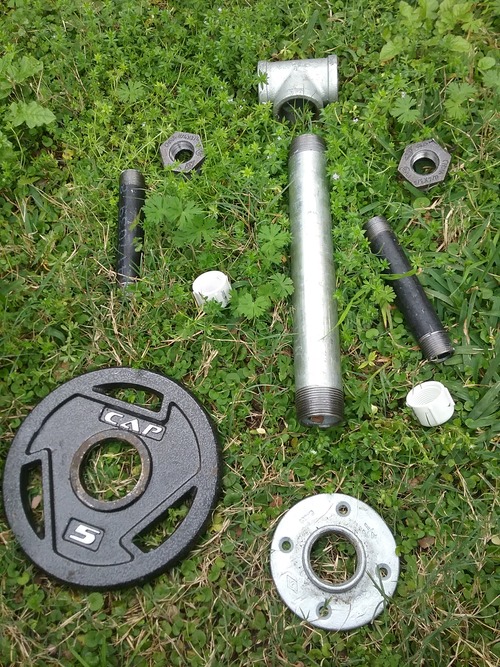
The pipe dimensions vary in this list than from in the picture.
- 1X 11/4" steel flange (bottom stop)
- 1X 11/4" steel pipe nipple; between 6" and 10" in length
- 1X 11/4" steel tee
- 2X 11/4" to 1" steel bushings (reducers) to connect handles; black steel is better for this
- 2X 1" steel pipe nipple (hand grips); 4" to 5" in length
- 2X 1" PVC screw on caps (handle edge covers)
- 1X 2" spring clap (not shown in image); it will fit a 11/4" pipe.
- Olympic weight plates
The example in the picture uses bushings, which costs more, and allows a smaller diameter, yet less strong steel pipe. Use bushings instead of couplings for connectors. PVC end caps are to keep sharp metal edges from potentially scraping against the exerciser and causing serious harm.
Alternatively, handles of 11/4" can replace the 1" handles and their bushings.
Putting it together

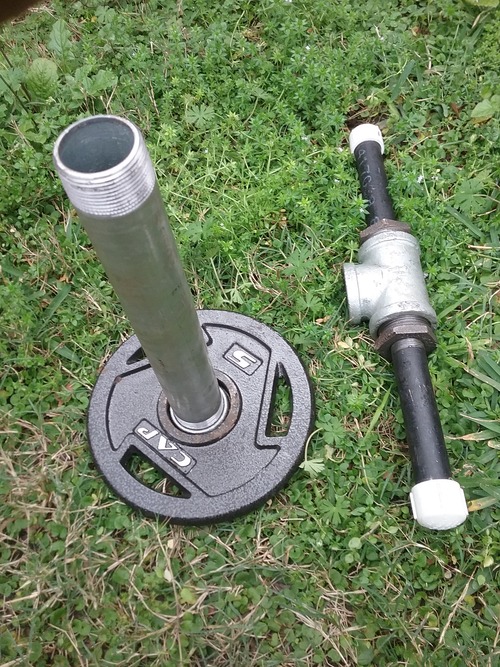
Use two pipe wrenches to screw the pieces together, until they are tightened as shown in the second picture and pictures below. The most important part to see that's snug is where the handles, bushings and tee meet. Don't use a pipe wrench to screw the tee to the pipe that carries the weights. Overtightening the PVC covers can cause the plastic to break.
Olympic plates will fit flush on the 11/4" flange and connecting pipe.
Steel pipe and fittings will rust easily on the outside, but as long as it is not laying in water or mud, it will hold its integrity. For some types of steel, rust usually stays on the outer layer. Rust on steel fittings, pipe and bushings also helps keep the connections together. Keep the bottom flange off of mud or standing water.
See heading section above for additional important construction and safety information.
Finished product
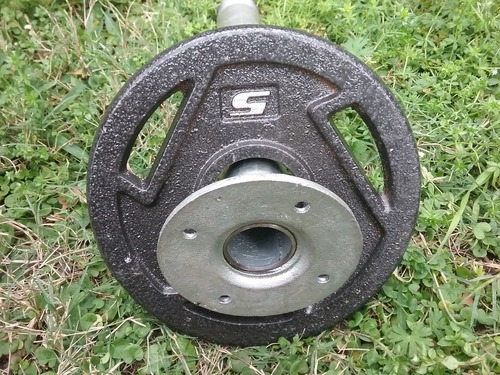

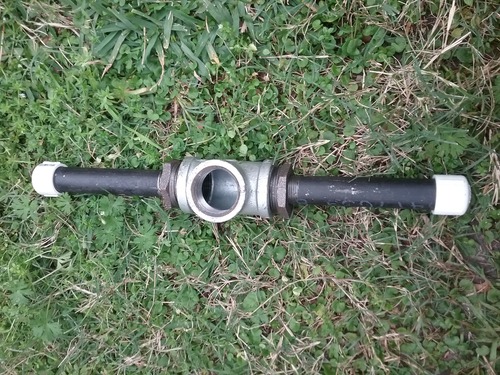
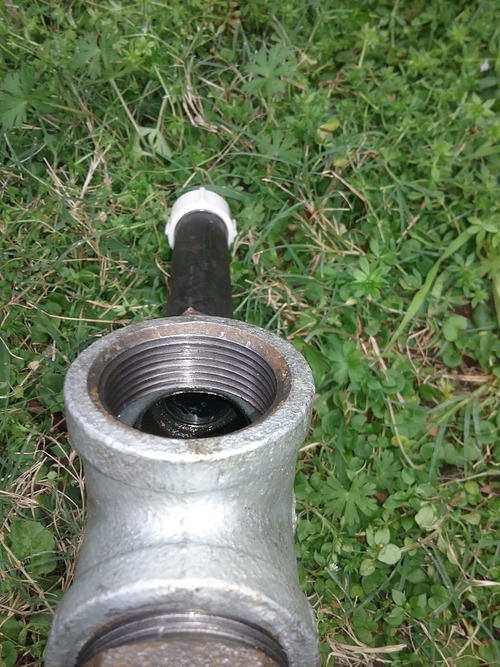
Comparison of different size weight plates
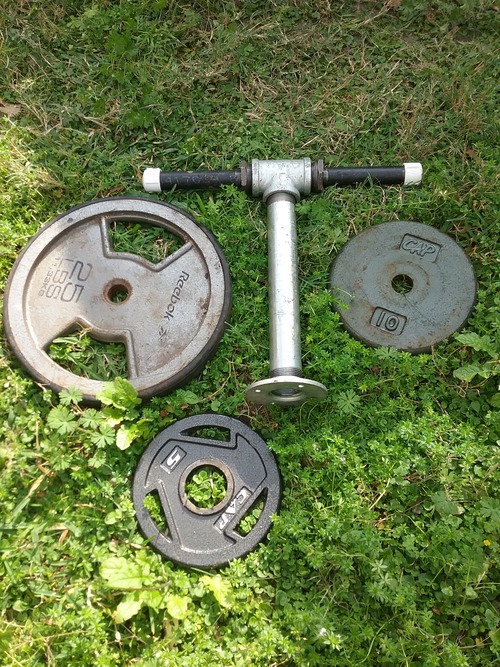
This is a finished heavy duty kettlebell, showing an Olympic weight that fits on it. An Olympic weight fits on a 11/4" pipe. The other two weights are standard sized. Both standard weights will fit on a 1/2" pipe.
3/4" or smaller diameter parts are not practical for the tee and handles, as there are stories of 3/4" t-handle DIY kettlebells breaking along the flange or tee, perhaps from slamming weights down which shouldn't be done anyway.
Slight variances of standard weights also may not all fit on a 3/4" steel pipe. Some standard weights will fit around a 3/4" steel pipe, but that depends on the brand, how it was manufactured, or if the plate is contracted or expanded due to temperature. For instance, the standard 10lb weight plate in the picture will fit on a 3/4" steel pipe. A standard 25lb weight plate may not fit on a 3/4" pipe, while an identical (same brand. weight and style) standard 25lb weight plate has, and while lighter standard weight plates of the same brand and style have.
Standard weights also do not sit flush on top of a 3/4" flange. A steel bushing can be used to connect a 1" or larger tee to a 1/2" pipe that connects to the bottom flange.
See heading section above for important safety information.
Parts from kettlebells used for pull up bar station
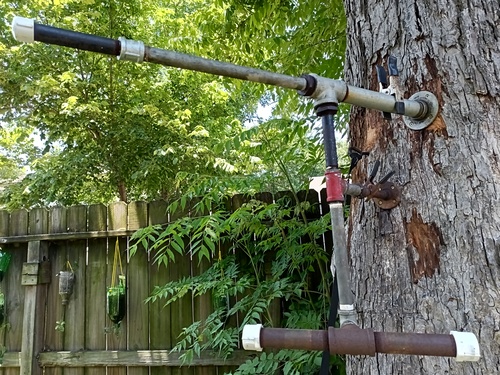
All of the metal parts of the kettlebells above were used in this pull up bar. A second small flange is connected to the tree below the larger flange, to support it from torque caused by weight on the pull up bar. Someone constructed this for me.
The long part across, the pullup bar, is ¾" pipe. It will be upgraded to 1" pipe. The pipe on the bottom is 1" for comparison, and is only attached to include it in the picture. Another exercise station attachment may be added from the bottom tee.
Flanges are used to connect to the tree, because they face the tree in a round shape, similar to tree branches. The tree can heal and grow around this easier than irregular, large and square shapes. Alloy screws are used to secure the flanges to the tree, so they won't rust away. The secondary iron flange is thick enough that it won't rust away in the foreseeable future.
